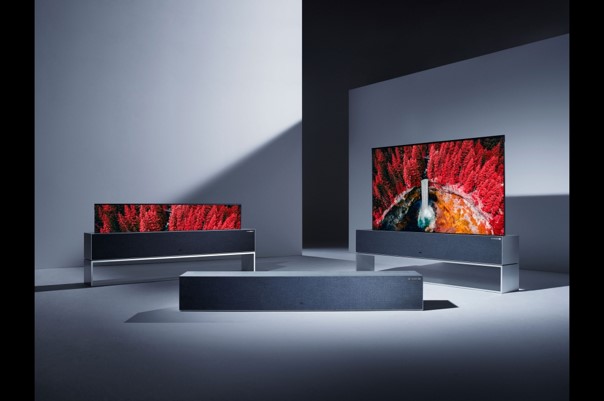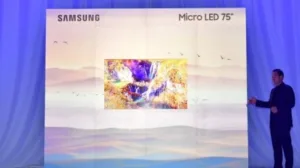Global manufacturers showcased their latest products and prototypes at CES 2019 giving a glimpse of what the future would bring. This year the focus was on AI, 5G and connected living.

AI will be making devices smarter, better and simpler to use, while 5G will empower connected devices with high speed and low latency. Display technology such as OLED, QLED, MicroLED and even LCD will be an integral part of this connected world by pushing their performance and capabilities to meet next generation product requirements.
TV – Rollable, Modular, Massive 8K, Better 4K
TV manufacturers embraced AI platforms (Alexa, Google Assistant, Bixby, and others) by embedding it into their TV products. Also, big TV companies such as Sony, LG, Vizio and others announced that their TVs would work with Apple AirPlay in 2019. Samsung TVs will get screen versions of iTune movies and TV apps. Companies are also using AI capabilities such as deep learning to enhance content and improve picture quality.
Rollable TV: OLED Shines
LG Electronics redefined TV space with differentiated design by introducing the first rollable OLED TV R, expected to launch commercially in spring 2019. The LG signature 65″ OLED 4K TV R can rise up and roll down with switch of a button, hiding the display in the body of a Dolby sound bar. It can also transform itself with three different viewing options:
- full view (large screen viewing),
- line view (partial viewing for information mode) and
- zero view (hidden).
This is truly differentiated design coming to the TV market, which was only made possible by the flexibility of OLED display technology. LG has already introduced the OLED TV W, wallpaper TV that can roll up or roll out. LG Display is the only volume production manufacturer of OLED TV displays.
OLED has gained strong presence in the premium TV market by differentiated design, deeper black, and superior wide viewing angle and color contrast. LG Electronics is the most successful TV brand using LG Display’s OLED TV panels. Brands such as Sony, Panasonic, Skyworth, TPV, Hisense, Konka and others have joined in the OLED TV market using LG Display’s panel. LG also showed an 88-inch 8K OLED TV with higher processing power and picture quality at CES.
 LG’s Rollable OLED TV
LG’s Rollable OLED TV
Modular design: Enabled by MicroLED
Samsung showcased the flexibility of modular designs for TV with its 75″ MicroLED TV and 219″ “The Wall” TVs as well as other sizes and configurations. Samsung has made technical advancements in ultra-fine pitch semiconductor packaging process (that narrows the gap between the microscopic LED chips) enabled it to create 4K MicroLED display in a smaller 75″ form factor.
MicroLEDs are self-emissive displays featuring millions of inorganic red, green and blue microscopic LED chips that emit their own light. The technology can scale to higher resolutions and support different aspect ratios. In theory, MicroLED displays are capable of very high brightness, high contrast ratio, wide color gamut, fast response time, low power, high flexibility and higher transparency. However, it is still extremely challenging to manufacture, scale and bring to market at a competitive cost.
 Samsung’s 75″ Microled TV Demonstration
Samsung’s 75″ Microled TV Demonstration
Massive 8K: QLED, LCD and OLED
Samsung unveiled its 98-inch QLED Quantum Dot (QD) based 8K TV adding to its line up of 65″, 75″, 82″ and 85″ sets. Samsung QLED TVs have been in the forefront, serving the premium market. TCL also announced an 8K QLED TV. Quantum dots (QD) can really empower LCD TV by enabling higher brightness (4000 cd/m² and above) and a significant increase in the color gamut (supporting more than 90% BT 2020).
LCD TVs have pushed their performance to ever-higher levels with QD display technology and direct full array blinking backlights and 8K resolution providing higher color gamut and deeper colour depth and details. Sony showcased 85″ and 98″ 8K LCD.
Beside very high prices for these massive sizes, there are also issues of 8K content availability. Companies are using AI-based technology to recognize and up-scale any content (regardless of the native resolution) to 8K. Leading display technology brands announced the recently formed 8K Association at CES to help develop the ecosystem. 8K TVs are going to be commercially available in 2019 and Samsung’s 65″ is expected to sell at around $5000.
Brighter better 4K TV: QD, HDR, and FLAD (Full Array Local dimming)
Companies also showed their latest 4K TVs with QD backlight technology, higher peak brightness, HDR, FLAD, a higher number of local dimming zones, and higher refresh rate capabilities. 4K content is also increasingly available. Vizio showcased its series of 65″ and 75″ P series QD 4K HDR smart TVs (with brightness up to 2900 cd/m²) with expansive colors and deeper blacks. Vizio is also bringing Quantum Dot technology to more of a mainstream market by offering more competitive prices (65″ at $1399 during the holiday season) in a variety of products (43″ to 65″).
Hisense is expected to offer a 65-inch QD TV at a $1,000 price in 2019 bringing it closer to the mainstream level. It got great attention by showing its ULED XD TV using two LCD panel (one 4K module and another 1080p gray scale panel) and Quantum Dot technology to achieve deeper black and higher brightness (2900 cd/m²). This technology has been used before in professional environments but not in consumer products (If One LCD is Not Enough, Try Two).
LG showed a 75″ 8K LCD TV renamed as nano-cell TV due to its wide color gamut nano-cell technology (Palomaki and Bertram Uncover LG’s “Nano Cell” Secret). Companies in China such as BOE, China Star and others are bringing in massive 10.5 Gen and higher LCD capacity over the next three to four years that are optimized for 65″ and above sized TV panels. This will result in more aggressive pricing for the TV panels in 2019, leading to a faster shift to larger size TVs.
Monitor: Super Size for Gaming
Super size monitors were also showcased at CES, specially for gaming applications. Dell demonstrated a prototype of 55″ UHD (3840 x 2160) OLED display (120Hz refresh rate) with very high contrast and fast response time for gamers. HP showed a 65″ 4K-Quantum Dot enhanced LCD BFGD (Big Format Gaming Display) integrated with G-sync and an Nvidia Shield. It is expected to be available in Q1 for $4,999. Also Razor got high attention with 27-inch IPS monitor with (2560x 1440) pixel format and 144Hz refresh rate. Samsung showed a high performance space monitor: 27-inch QHD and 32-inch 4KUHD. LG display was showing a 27″ UltraHD monitor with an oxide backplane.
Auto: Connected Driving, Bigger, Curvier and Higher performance
Connected driving was a major focus at CES. The emerging 5G technology is expected to be integrated to connected auto concept and design. Samsung and Harman showcased its “digital cockpit 2019”, offering enhanced connected car experience focused on connectivity, personalization and safety. It has six auto displays based on different technology including LCD, OLED, and QLED. Passenger displays were 12.2″ OLEDs. The general trend for auto display is bigger, curvier, higher performance and free-form to integrate with car interior design. In-cell touch solutions will provide thinner panels for design freedom.
Harman’s “in-vehicle infotainment system” features an integrated smartphone and connectivity with other devices. Besides Carplay and Android auto, it also included AI support such as Alexa, Google and Bixby. Byton, a startup from China showcased a concept car with curved 48″ wrap-around display that stretches across the dashboard and a smaller screen integrated into steering wheel.
 The Samsung/Harman auto display concept
The Samsung/Harman auto display concept
Smartphone: bigger, better, foldable
Motorola showed 5G capable smartphones with 6″ OLED displays. LG and Huawei showed smartphones with 6.x and 6.x OLED respectively. Royole showcased the first foldable smartphone “FlexPai” that unfolds to an 8″ tablet. Samsung has announced (at its Developer Conference 2018) its plan to start mass production of its first foldable smartphone in 2019.
Also companies such as Huawei, LG, Google, Lenovo and others are planning to introduce foldable smartphones in the future. Foldable smartphone prices are expected to be in the range of $1500 to $2500, which are substantially higher than current high end user prices. There are still many challenges including process technology, materials, manufacturing issues, high capex, higher costs, durability of the products, design acceptance, and consumer willingness to pay higher prices for the new designs.
Display technology such as OLED, QLED, MicroLED and LCD are introducing bigger and better products to meet next generation requirements, but high price, manufacturing challenges and other issues may keep many of these products out of the mainstream market in the near term. Sweta Dash
Sweta Dash is the founding president of Dash-Insights, a market research and consulting company specializing in the display industry. For more information, contact [email protected] or visit www.dash-insight.com

